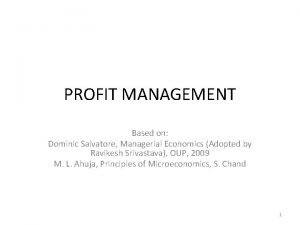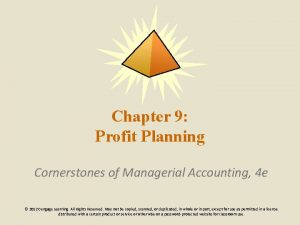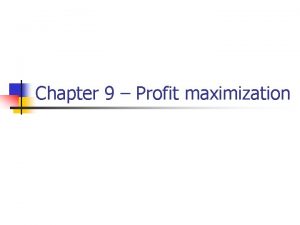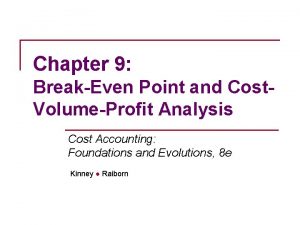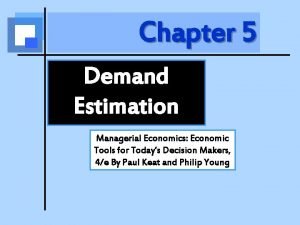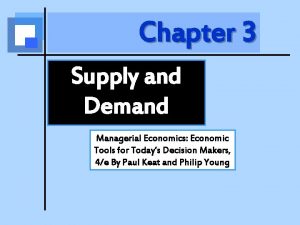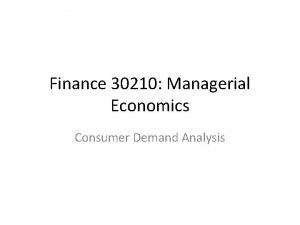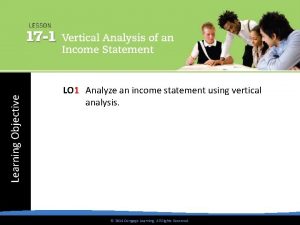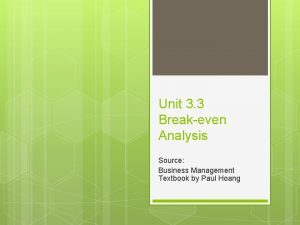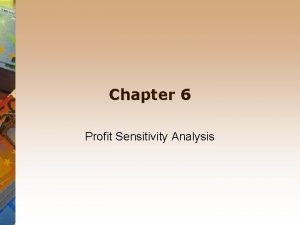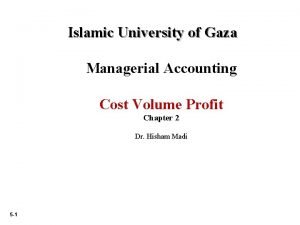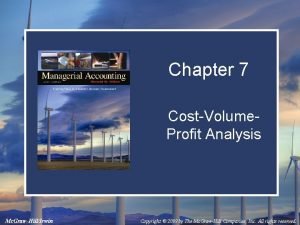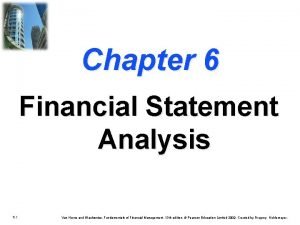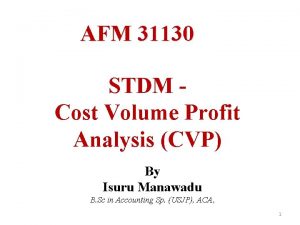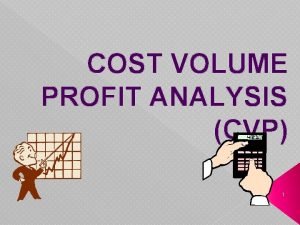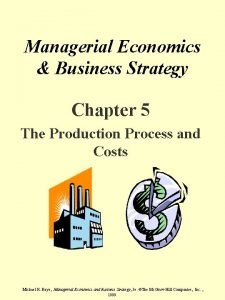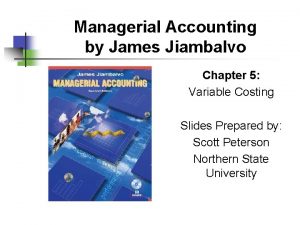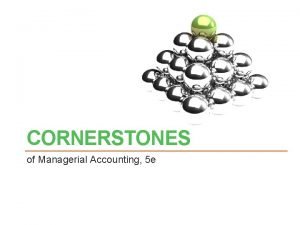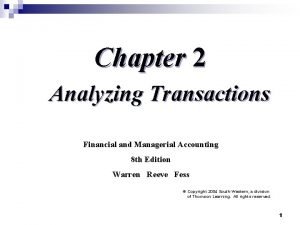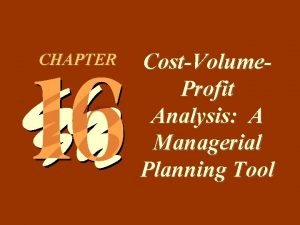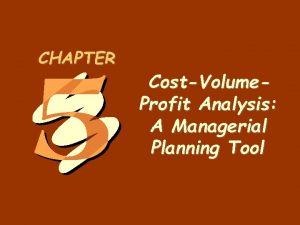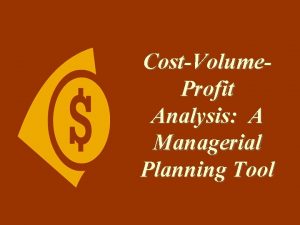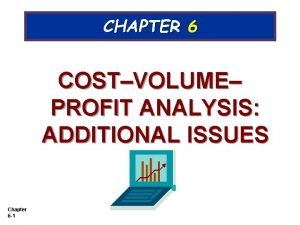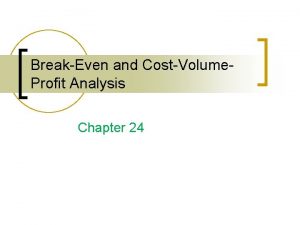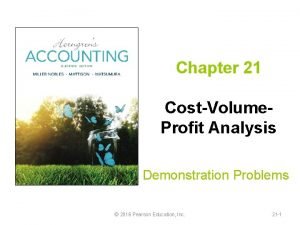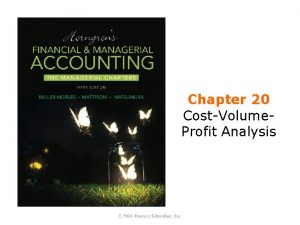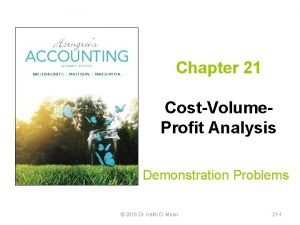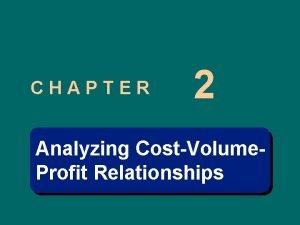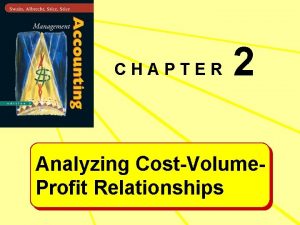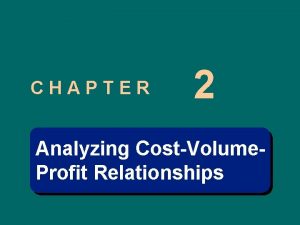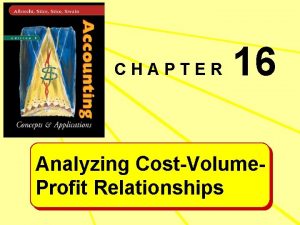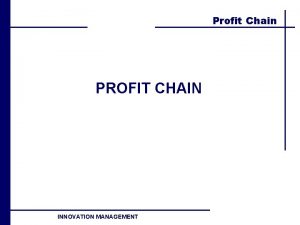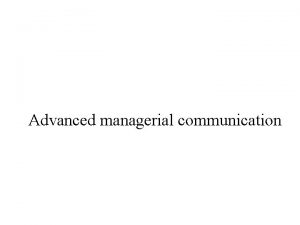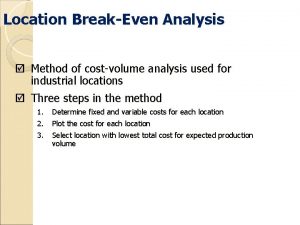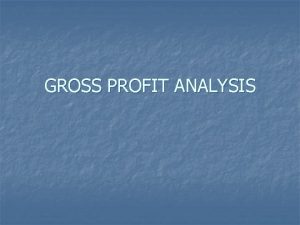16 1 CHAPTER CostVolume Profit Analysis A Managerial






















- Slides: 22

16 -1 CHAPTER Cost-Volume. Profit Analysis: A Managerial Planning Tool

16 -2 Multiple-Product Analysis Sales Less: Variable expenses Contribution margin Less: Direct fixed expenses Product margin Less: Common fixed expenses Operating income Mulching Mower $480, 000 390, 000 $ 90, 000 30, 000 $ 60, 000 Riding Mower Total $640, 000 $1, 120, 000 480, 000 870, 000 $160, 000 $ 250, 000 40, 000 70, 000 $120, 000 $ 180, 000 26, 250 $ 153, 750

16 -3 Income Statement: B/E Solution Mulching Mower Sales Less: Variable expenses Contribution margin Less: Direct fixed expenses Segment margin Less: Common fixed expenses Operating income $184, 800 150, 150 $ 34, 650 30, 000 $ 4, 650 Riding Mower $246, 400 184, 800 $ 61, 600 40, 000 $ 23, 600 Total $431, 200 334, 950 $ 96, 250 70, 000 $ 26, 250 $ 0

16 -4 The profit-volume graph portrays the relationship between profits and sales volume.

16 -5 Example The Tyson Company produces a single product with the following cost and price data: Total fixed costs Variable costs per unit Selling price per unit $100 5 10

Profit-Volume Graph (40, $100) Profit $100— or Loss 80— I = $5 X - $100 60— 40— 20— 0— | 5 - 20— Break-Even Point (20, $0) | | 10 15 - 40— Loss -60— -80— -100— (0, -$100) | | 20 25 | 30 | | 35 40 | | 45 50 Units Sold 16 -6

16 -7 The cost-volume-profit graph depicts the relationship among costs, volume, and profits.

16 -8 Cost-Volume-Profit Graph Revenue $500 -450 -400 -350 -300 -250 -200 -150 -100 -Loss 50 -| 0 -- | 5 10 Total Revenue 0) 0 1 ($ t i f Pro Total Cost Variable Expenses ($5 per unit) Break-Even Point (20, $200) Fixed Expenses ($100) | 15 | 20 | 25 | 30 | 35 | 40 | | | 45 50 55 Units Sold | 60

16 -9 Assumptions of C-V-P Analysis 1. The analysis assumes a linear revenue function and a linear cost function. 2. The analysis assumes that price, total fixed costs, and unit variable costs can be accurately identified and remain constant over the relevant range. 3. The analysis assumes that what is produced is sold. 4. For multiple-product analysis, the sales mix is assumed to be known. 5. The selling price and costs are assumed to be known with certainty.

Relevant Range 16 -10 $ Total Revenue Total Cost Relevant Range Units

Alternative 1: If advertising expenditures increase by 16 -11 $8, 000, sales will increase from 1, 600 units to 1, 725 units. Units sold Unit contribution margin Total contribution margin Less: Fixed expenses Profit BEFORE THE INCREASED ADVERTISING WITH THE INCREASED ADVERTISING 1, 600 x $75 $120, 000 45, 000 $ 75, 000 1, 725 x $75 $129, 375 53, 000 $ 76, 375 DIFFERENCE IN PROFIT Change in sales volume Unit contribution margin Change in contribution margin Less: Change in fixed expenses Increase in profits 125 x $75 $9, 375 8, 000 $1, 375

Alternative 2: A price decrease from $400 to $375 per 16 -12 lawn mower will increase sales from 1, 600 units to 1, 900 units. Units sold Unit contribution margin Total contribution margin Less: Fixed expenses Profit BEFORE THE PROPOSED CHANGES WITH THE PROPOSED CHANGES 1, 600 x $75 $120, 000 45, 000 $ 75, 000 1, 900 x $50 $95, 000 45, 000 $50, 000 DIFFERENCE IN PROFIT Change in contribution margin Less: Change in fixed expenses Decrease in profits $ -25, 000 -------$ -25, 000

Alternative 3: Decreasing price to $375 and increasing 16 -13 advertising expenditures by $8, 000 will increase sales from 1, 600 units to 2, 600 units. Units sold Unit contribution margin Total contribution margin Less: Fixed expenses Profit BEFORE THE PROPOSED CHANGES WITH THE PROPOSED CHANGES 1, 600 x $75 $120, 000 45, 000 $ 75, 000 2, 600 x $50 $130, 000 53, 000 $ 77, 000 DIFFERENCE IN PROFIT Change in contribution margin Less: Change in fixed expenses Increase in profit $10, 000 8, 000 $ 2, 000

16 -14 Margin of Safety Assume that a company has the following projected income statement: Sales Less: Variable expenses Contribution margin Less: Fixed expenses Income before taxes Break-even point in dollars (R): $100, 000 60, 000 $ 40, 000 30, 000 $ 10, 000 R = $30, 000 ÷. 4 = $75, 000 Safety margin = $100, 000 - $75, 000 = $25, 000

16 -15 Degree of Operating Leverage (DOL) DOL = $40, 000/$10, 000 = 4. 0 Now suppose that sales are 25% higher than projected. What is the percentage change in profits? Percentage change in profits = DOL x percentage change in sales Percentage change in profits = 4. 0 x 25% = 100%

16 -16 Degree of Operating Leverage (DOL) Proof: Sales Less: Variable expenses Contribution margin Less: Fixed expenses Income before taxes $125, 000 75, 000 $ 50, 000 30, 000 $ 20, 000

CVP and ABC 16 -17 Assume the following: Sales price per unit $15 Variable cost 5 Fixed costs (conventional) $180, 000 Fixed costs (ABC) $100, 000 with $80, 000 subject to ABC analysis Other Data: Unit Level of Variable Activity Driver Costs Driver Setups $500 100 Inspections 50 600

CVP and ABC 1. What is the BEP under conventional analysis? BEP = $180, 000 ÷ $10 = 18, 000 units 16 -18

CVP and ABC 2. What is the BEP under ABC analysis? BEP = [$100, 000 + (100 x $500) + (600 x $50)]/$10 = 18, 000 units 16 -19

CVP and ABC 3. What is the BEP if setup cost could be reduced to $450 and inspection cost reduced to $40? BEP = [$100, 000 + (100 x $450) + (600 x $40)]/$10 = 16, 900 units 16 -20

16 -21 Chapter Sixteen The End

16 -22
 Profit management in managerial economics
Profit management in managerial economics Profit planning managerial accounting
Profit planning managerial accounting Profit
Profit Economic profit vs accounting profit
Economic profit vs accounting profit Post acquisition profit is which profit
Post acquisition profit is which profit Break even point in dollars formula
Break even point in dollars formula Basic assumptions of cvp analysis
Basic assumptions of cvp analysis What is demand estimation in managerial economics
What is demand estimation in managerial economics Demand and supply analysis in managerial economics
Demand and supply analysis in managerial economics Managerial economics demand analysis
Managerial economics demand analysis Vertical analysis gross profit
Vertical analysis gross profit Contribution analysis table
Contribution analysis table Profit sensitivity analysis
Profit sensitivity analysis Profit analysis
Profit analysis Cost volume profit analysis graph
Cost volume profit analysis graph Profit analysis
Profit analysis Isuru manawadu
Isuru manawadu Objectives of cvp analysis
Objectives of cvp analysis The relative proportion of variable fixed or mixed
The relative proportion of variable fixed or mixed Ecomics
Ecomics Managerial accounting chapter 5 solutions
Managerial accounting chapter 5 solutions Managerial accounting chapter 13 solutions
Managerial accounting chapter 13 solutions Financial accounting chapter 2 solutions
Financial accounting chapter 2 solutions
